The kingfishers in flight are a work in progress but I’m definitely getting there.
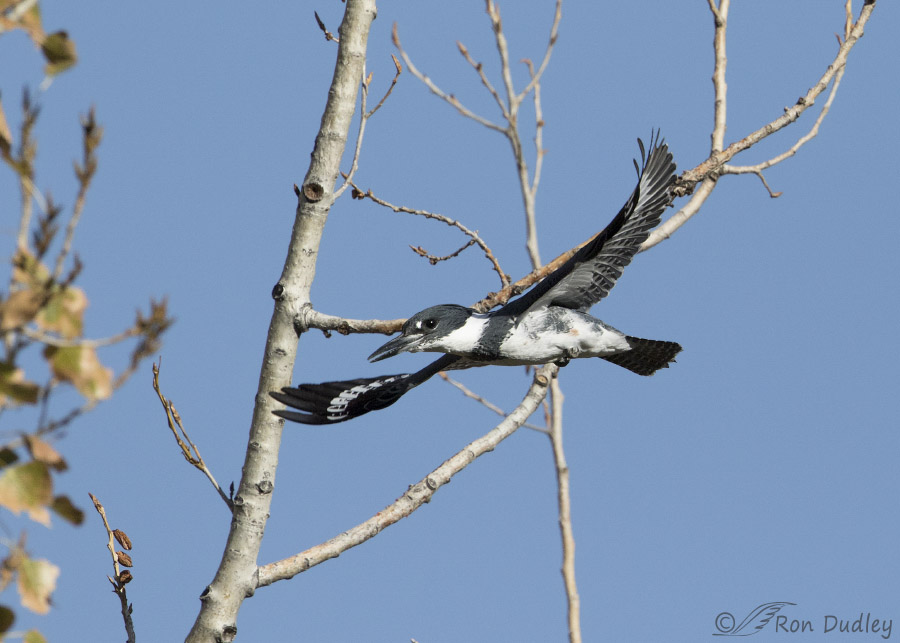
1/8000, f/6.3, ISO 640, Canon 7D Mark II, Canon EF 500mm f/4L IS II USM + EF 1.4 III Extender, not baited, set up or called in
This photo of the same male Belted Kingfisher I’ve been photographing for a while now was taken yesterday. My two biggest problems with photographing kingfishers in flight are keeping them in frame (kingfishers are fast and erratic fliers) and getting them sharp, especially with all the trees in the close background that want to grab my active focus points. I have quite a few shots of this male in flight that aren’t quite tack sharp but this one is very, very close.
The branches behind him are a bit of a bother but that’s the way it goes with kingfishers. The bird is centered in the frame because I had no choice.
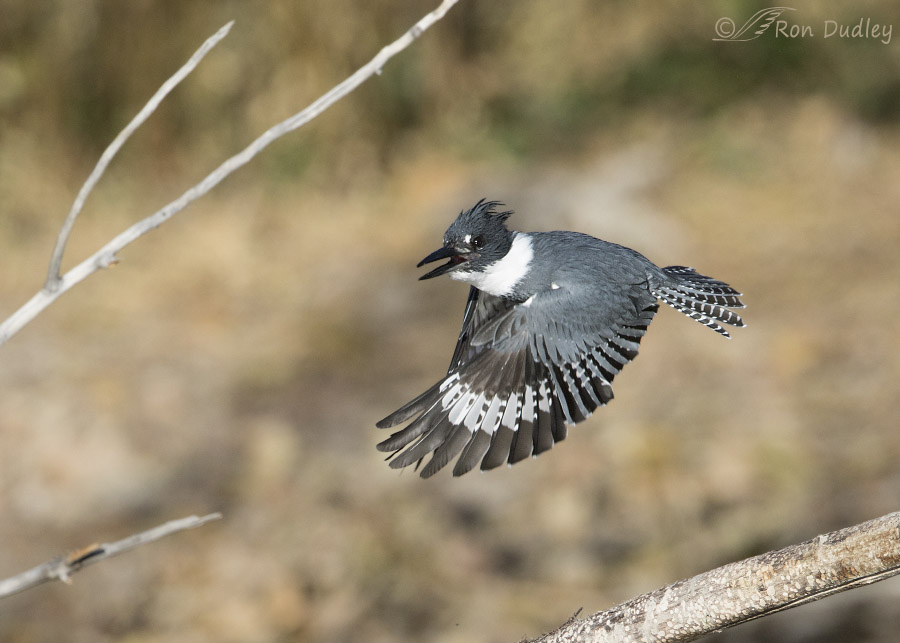
1/4000, f/6.3, ISO 640, Canon 7D Mark II, Canon EF 500mm f/4L IS II USM + EF 1.4 III Extender, not baited, set up or called in
This shot was taken two days ago soon after he lifted off from his favorite “dining table” perch and almost immediately after he had gobbled down a fish. I was lucky to catch him with a clean background with his beak open, his tail spread out and a wing position I like.
I’ve been happy with my progress with kingfisher flight shots in most situations but success with one type still eludes me…
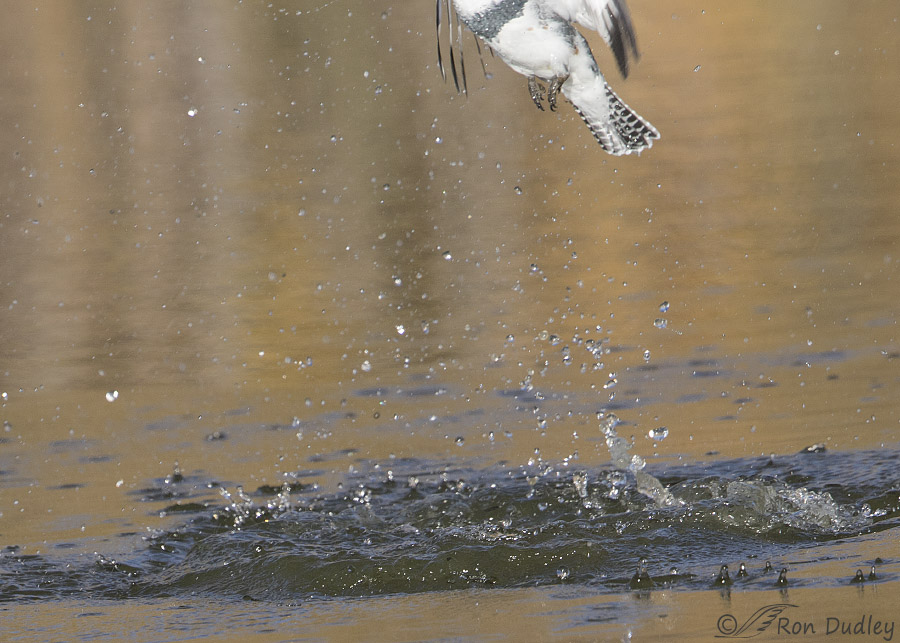
1/1600, f/6.3, ISO 640, Canon 7D Mark II, Canon EF 500mm f/4L IS II USM + EF 1.4 III Extender, not baited, set up or called in
and that’s when he’s coming out of the water after diving for a fish (they only spend about one second in the water). As you can see I’m getting close but still no cigar.
This type of shot may be the most challenging I’ve ever repeatedly attempted to get and failed of any bird species. But I’m determined to eventually succeed if the kingfishers continue to “cooperate” (which may not happen for more reasons than one).
- Note to photographers: These first three images illustrate why I have to start out with such incredibly high shutter speeds while the male is perched in a high tree in bright light. I shoot in aperture priority which means my SS changes in different lighting conditions. When he takes off from a high perch his intention is often to dive for a fish and I really want to capture him coming out of the water with a fish but the water is usually much darker and (as you can see) it drops my SS dramatically. So I have to start out high so it’s still fast enough to get the bird sharp as he exits the water (hopefully 1/2500 sec minimum). I certainly don’t have enough time to make any camera setting adjustments between his takeoff and his exit from the water.
Ron
PS – I was very excited to see my first two Rough-legged Hawks of the season yesterday morning in Box Elder County. I only got documentary shots of them from great distances but I was still very happy to see them.
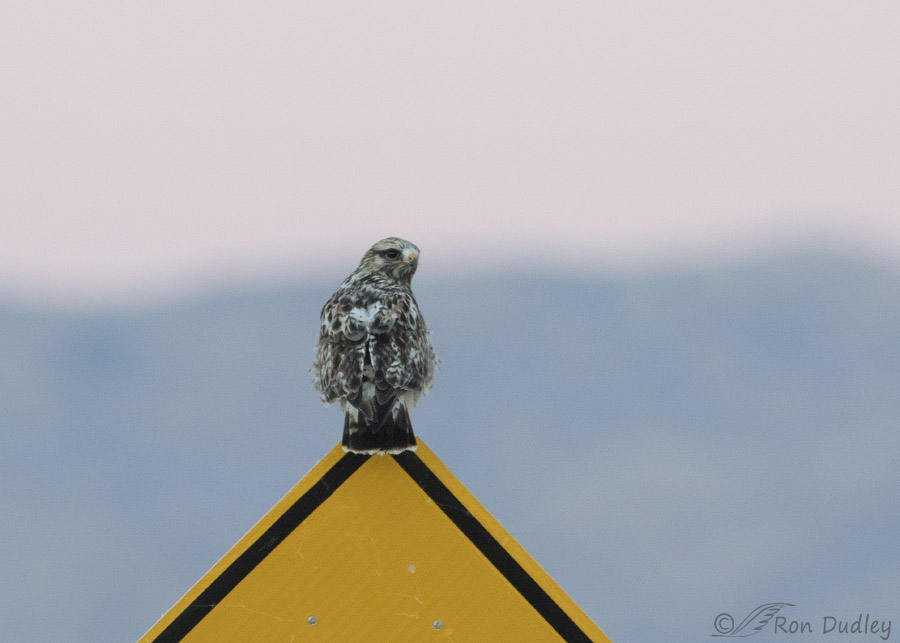
We found the first one, an adult male, a few minutes before sunrise. Both birds were quite nervous after spending the breeding season in the tundra and taiga regions of arctic and subarctic Alaska and Canada. Hopefully they’ll settle down a little soon.
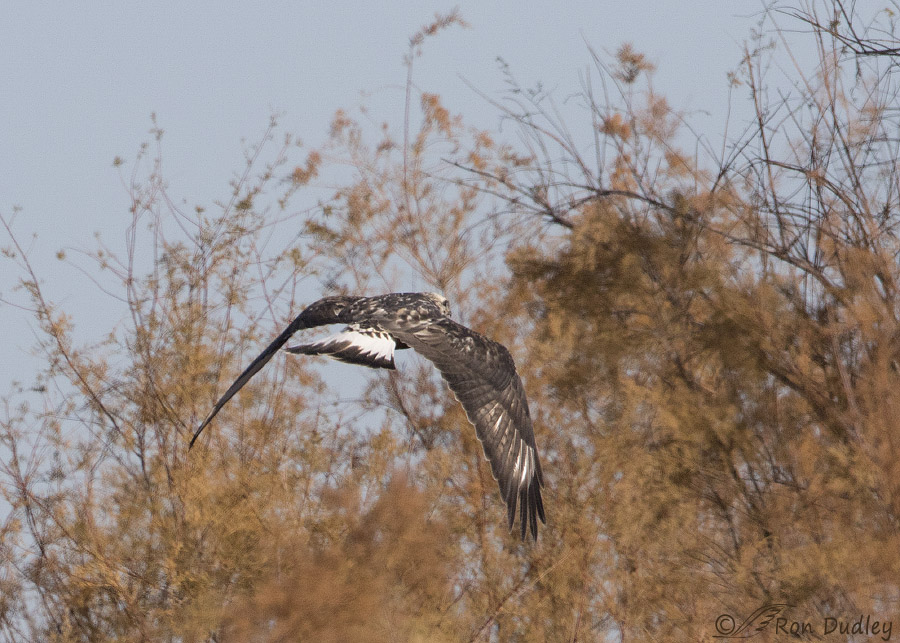
We found the second roughie a little over two hours later, also in Box Elder County. It was perched in the trees with its back to me but I chose to post this butt shot of it in flight for the different look at the plumage.
I absolutely love it when the Rough-legged hawks come back for the winter. They’re a worthy temporary replacement for our Swainson’s Hawks that winter in South America.


So were your ears a-burnin’ about 3 pm, your time? Our shelter was doing a mobile adoption/outreach event today and there was a local Audubon Society and a wildlife rescue organization there as well. I talked up your blog to both. The WR brought several education raptors, including a GHO, a barn owl, a burrowing owl, and a male and female kestrel. Thanks to your blog, I was able to correctly ID all of them (and sex the kestrels). Your teaching has sunk in!
These are great shots — I can imagine the vocab for kingfisher #3. I especially like the roughie on the sign. For some reason, that yellow diamond accentuates the bird for me.
I especially like the roughie on the sign. For some reason, that yellow diamond accentuates the bird for me.
Marty, If my ears had been burning I’d have been in flames. There’s a LOT of fuel there!
Absolutely delighted to know that what you’ve learned here has been rewarding for you. That made my day, it truly did (and I needed it).
Speaking of kestrels I think you might enjoy tomorrow’s post…
Love that you are steadily kicking your nemesis shots out of the park. And am confident that you WILL catch the kingfisher emerging with a fish.
I am so very glad that his anger at the cop (Kingfisher’s Peace Matters) didn’t extend to you the next day.
And hooray for the return for another raptor.
EC, yesterday he was still noticeably more skittish than normal. He only came into his close (and favorite) fishing perch once and that wasn’t for very long. Hopefully he’ll forget about that incident soon.
Fantastic series Ron!
Charlotte
Thanks, Charlotte.
Interesting information….I ALWAYS enjoy your comments as much as the photos… And that’s saying a lot!!!
And it’s appreciated a lot on this end. Thank you, Patty.
Love the Kingfisher shots, even the last one… These shots document how noisy they are when they fly. The reason I spotted the last one we saw was because it was making so much noise. The first two shots are very nice. Glad you got to see your first Roughies of the year. I’m not sure they come down this far (and if they do, I probably wouldn’t recognize them).
Yes, they make a lot of noise and this male is particularly vocal. He REALLY didn’t like having that cop around a couple of days ago and he let that be known!
Great images of the Kingfisher Ron. I love the second one as it shows him vocalizing while also looking into what looks like the start of a banked turn.
Interesting discussion on Av and the shutter speed too. Good timing as I have been writing up a tutorial on manual exposure the past week. You are a great example of a photographer who really gets great images using Av mode. This scenario is a good example of when Av mode makes more sense.
Wow, RLHA hawks already! I usually do not see them in Southern Colorado and Northern New Mexico until there is snow on the ground.
Ed, this is roughly (pun intended) the time we usually see our first Rough-legged Hawks of the season, even though it’s been very warm lately. And you’re absolutely right about the upcoming banked turn of the kingfisher in the second photo. Immediately after that shot was taken he turned abruptly in my direction to land on his favorite fishing perch again.
I’ve often wondered if I’d started out using manual if I’d still be using it today. Probably so, since I’m such a creature of habit. I just like to stick with the system I know best and for me that’s definitely aperture priority.
If possible I’d be interested in seeing your tutorial if and when you publish it…
Wonderful shots and interesting reading!
Thanks for the SS lesson.
Roughies are back with you, can’t wait till they come back here. However, our weather has been too warm lately, which I attribute to why our bird populations have acted differently, weird, whatever. Warm days and cool nights are just not normal for end of October for middle Vermont. It might have something to do with the start of hunting season, but can’t see why that would have any affect on few songbirds around the feeders. We are all hopeful that colder weather will bring us back to normal Yet, not far away we do have 1700 Snow Geese in a large protected area with hunters practically ringing that protected area with their decoys. I won’t go there!
Thanks for sharing, Ron – love these lessons!!
Thanks, Dick. We have similar things going on with birds around here. Bird populations seem to be so different from year to year that it’s hard to reliably point to the cause but I’m sure that climate change is a significant part of the problem. I’ve been worried about this happening for years now.
Nice! Even if not perfect………… The 2nd shot really shows the personality of the kingfisher!:) The ones here are usually noted on the power lines high above the creek and facing NW so lighting always and issue or screaming through the yard at dusk. At the moment have a male Kestrel taking up that perch doing the same thing tho he stays closer to land. The Roughie shots are great for the colors in them.:)
“The 2nd shot really shows the personality of the kingfisher”
And as you know, kingfishers have a LOT of personality, Judy. This male has it in spades. Thank you.